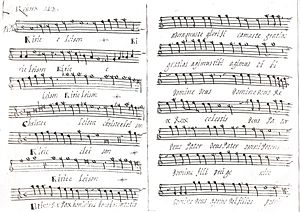Miguel de Irízar facts for kids
Miguel de Irízar y Domenzain (1635–1684) was an important Spanish composer from the Baroque period. He wrote music hundreds of years ago, when music sounded very different from today.
Contents
Who Was Miguel de Irízar?
Miguel de Irízar was born in a town called Artajona in Spain. When he was young, he trained to be a choirboy. He learned music in the cities of León and Toledo.
His Career as a Music Director
In August 1657, Miguel de Irízar became a maestro de capilla in Vitoria. A maestro de capilla was like a music director for a church or cathedral. They were in charge of all the music.
Later, in August 1671, he moved to Segovia Cathedral. He worked there for the last thirteen years of his life. He passed away in Segovia in 1684.
What His Letters Tell Us
Many of Irízar's letters have been saved in the Segovia Cathedral. There are 362 letters in total, written between 1663 and 1684. These letters are very special because they tell us a lot about music from that time.
Other cathedrals often asked Irízar to write new music for them. He also traded music with other famous composers like Cristóbal Galán and Carlos Patiño. Some of his music even traveled across the ocean to the New World!
The letters also explain how music was performed back then. They show that villancicos (a type of Spanish song) were very popular. These songs quickly spread from one cathedral to another.
What Kind of Music Did He Write?
Miguel de Irízar wrote many different types of music for the church. His compositions include:
- Masses (music for church services)
- Motets (short pieces of sacred music)
- Lamentations (songs of sorrow)
- Villancicos (popular Spanish songs, often for Christmas)
- Tonos a la Navidad (songs for Christmas)
Listen to His Music
You can still listen to Miguel de Irízar's music today! One recording is:
- Miguel de Irízar. Mass for 6 voices. 10 Christmas pieces. Ecos y afectos. Performed by Capilla Jeronimo de Carrion, directed by Alicia Lazaro. This was released by Verso VRS2024 in Spain in 2004.
See also
 In Spanish: Miguel de Irízar para niños
In Spanish: Miguel de Irízar para niños


